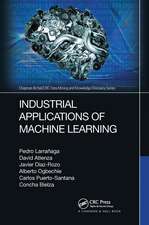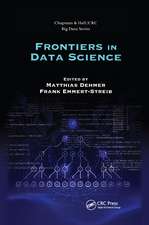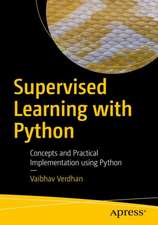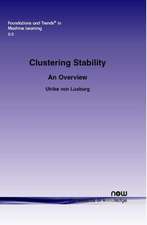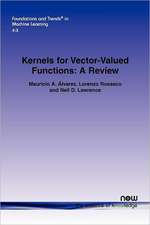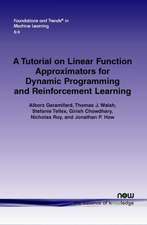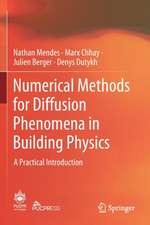Nonlinear Dimensionality Reduction Techniques: A Data Structure Preservation Approach
Autor Sylvain Lespinats, Benoit Colange, Denys Dutykhen Limba Engleză Paperback – 4 dec 2022
Performing diagnosis of an energy system requires identifying relations between observed monitoring variables and the associated internal state of the system. Dimensionality reduction, which allows to represent visually a multidimensional dataset, constitutes a promising tool to help domain experts to analyse these relations. This book reviews existing techniques for visual data exploration and dimensionality reduction such as tSNE and Isomap, and proposes new solutions to challenges in that field.
In particular, it presents the new unsupervised technique ASKI and the supervised methods ClassNeRV and ClassJSE. Moreover, MING, a new approach for local map quality evaluation is also introduced. These methods are then applied to the representation of expert-designed fault indicators for smart-buildings, I-V curves for photovoltaic systems and acoustic signals for Li-ion batteries.
| Toate formatele și edițiile | Preț | Express |
|---|---|---|
| Paperback (1) | 816.07 lei 6-8 săpt. | |
| Springer International Publishing – 4 dec 2022 | 816.07 lei 6-8 săpt. | |
| Hardback (1) | 822.32 lei 6-8 săpt. | |
| Springer International Publishing – 3 dec 2021 | 822.32 lei 6-8 săpt. |
Preț: 816.07 lei
Preț vechi: 1020.09 lei
-20% Nou
Puncte Express: 1224
Preț estimativ în valută:
156.17€ • 169.58$ • 131.19£
156.17€ • 169.58$ • 131.19£
Carte tipărită la comandă
Livrare economică 23 aprilie-07 mai
Preluare comenzi: 021 569.72.76
Specificații
ISBN-13: 9783030810283
ISBN-10: 3030810283
Pagini: 247
Ilustrații: XLIII, 247 p. 100 illus., 88 illus. in color.
Dimensiuni: 155 x 235 mm
Greutate: 0.41 kg
Ediția:1st ed. 2022
Editura: Springer International Publishing
Colecția Springer
Locul publicării:Cham, Switzerland
ISBN-10: 3030810283
Pagini: 247
Ilustrații: XLIII, 247 p. 100 illus., 88 illus. in color.
Dimensiuni: 155 x 235 mm
Greutate: 0.41 kg
Ediția:1st ed. 2022
Editura: Springer International Publishing
Colecția Springer
Locul publicării:Cham, Switzerland
Cuprins
1 Data science context.- 1.1 Data in a metric space.- 1.1.1 Measuring dissimilarities and similarities .- 1.1.2 Neighbourhood ranks.- 1.1.3 Embedding space notations.- 1.1.4 Multidimensional data .- 1.1.5 Sequence data.- 1.1.6 Network data.- 1.1.7 A few multidimensional datasets .- 1.2 Automated tasks.- 1.2.1 Underlying distribution.- 1.2.2 Category identification.- 1.2.3 Data manifold analysis.- 1.2.4 Model learning.- 1.2.5 Regression.- 1.3 Visual exploration.- 1.3.1 Human in the loop using graphic variables.- 1.3.2 Spatialization and Gestalt principles.- 1.3.3 Scatter plots.- 1.3.4 Parallel coordinates.- 1.3.5 Colour coding.- 1.3.6 Multiple coordinated views and visual interaction.- 1.3.7 Graph drawing.- 2 Intrinsic dimensionality.- 2.1 Curse of dimensionality.- 2.1.1 Data sparsity.- 2.1.2 Norm concentration.- 2.2 ID estimation.- 2.2.1 Covariance-based approaches.- 2.2.2 Fractal approaches.- 2.2.3 Towards local estimation.- 2.3 TIDLE .- 2.3.1 Gaussian mixture modelling.- 2.3.2 Test of TIDLE on a two clusters case.- 3 Map evaluation.- 3.1 Objective and practical indicators.- 3.1.1 Subjectivity of indicators.- 3.1.2 User studies on specific tasks.- 3.2 Unsupervised global evaluation.- 3.2.1 Types of distortions.- 3.2.2 Link between distortions and mapping continuity.- 3.2.3 Reasons of distortions ubiquity.- 3.2.4 Scalar indicators.- 3.2.5 Aggregation.- 3.2.6 Diagrams.- 3.3 Class-aware indicators.- 3.3.1 Class separation and aggregation.- 3.3.2 Comparing scores between the two spaces.- 3.3.3 Class cohesion and distinction.- 3.3.4 The case of one cluster per class.- 4 Map interpretation.- 4.1 Axes recovery.- 4.1.1 Linear case: biplots .- 4.1.2 Non-linear case.- 4.2 Local evaluation.- 4.2.1 Point-wise aggregation.- 4.2.2 One to many relations with focus point.- 4.2.3 Many to many relations.- 4.3 MING.- 4.3.1 Uniform formulation of rank-based indicator.- 4.3.2 MING graphs.- 4.3.3 MING analysis for a toy dataset.- 4.3.4 Impact of MING parameters.- 4.3.5 Visual clutter.- 4.3.6 Oil flow.- 4.3.7 COIL-20 dataset.- 4.3.8 MING perspectives.- 5 Unsupervised DR.- 5.1 Spectral projections.- 5.1.1 Principal Component Analysis.- 5.1.2 Classical MultiDimensional Scaling.- 5.1.3 Kernel methods: Isompap, KPCA, LE.- 5.2 Non-linear MDS.- 5.2.1 Metric MultiDimensional Scaling.- 5.2.2 Non-metric MultiDimensional Scaling.- 5.3 Neighbourhood Embedding.- 5.3.1 General principle: SNE.- 5.3.2 Scale setting.- 5.3.3 Divergence choice: NeRV and JSE.- 5.3.4 Symmetrization.- 5.3.5 Solving the crowding problem: tSNE.- 5.3.6 Kernel choice.- 5.3.7 Adaptive Student Kernel Imbedding.- 5.4 Graph layout.- 5.4.1 Force directed graph layout: Elastic Embedding.- 5.4.2 Probabilistic graph layout: LargeVis.- 5.4.3 Topological method UMAP.- 5.5 Artificial neural networks.- 5.5.1 Auto-encoders.- 5.5.2 IVIS.- 6 Supervised DR.- 6.1 Types of supervision.- 6.1.1 Full supervision.- 6.1.2 Weak supervision.- 6.1.3 Semi-supervision.- 6.2 Parametric with class purity.- 6.2.1 Linear Discriminant Analysis.- 6.2.2 Neighbourhood Component Analysis.- 6.3 Metric learning.- 6.3.1 Mahalanobis distances.- 6.3.2 Riemannian metric.- 6.3.3 Direct distances transformation.- 6.3.4 Similarities learning.- 6.3.5 Metric learning limitations.- 6.4 Class adaptive scale.- 6.5 Classimap.- 6.6 CGNE.- 6.6.1 ClassNeRV stress.- 6.6.2 Flexibility of the supervision.- 6.6.3 Ablation study.- 6.6.4 Isolet 5 case study.- 6.6.5 Robustness to class misinformation.- 6.6.6 Extension to the type 2 mixture: ClassJSE.- 6.6.7 Extension to semi-supervision and weak-supervision.- 6.6.8 Extension to soft labels.- 7 Mapping construction.- 7.1 Optimization.- 7.1.1 Global and local optima.- 7.1.2 Descent algorithms.- 7.1.3 Initialization.- 7.1.4 Multi-scale optimization.- 7.1.5 Force-directed placement interpretation.- 7.2 Acceleration strategies.- 7.2.1 Attractive forces approximation.- 7.2.2 Binary search trees.- 7.2.3 Repulsive forces.- 7.2.4 Landmarks approximation.- 7.3 Out of sample extension.- 7.3.1 Applications.- 7.3.2 Parametric case .- 7.3.3 Non-parametric stress with neural network model.- 7.3.4 Non-parametric case.- 8 Applications.- 8.1 Smart buildings commissioning.- 8.1.1 System and rules.- 8.1.2 Mapping.- 8.2 Photovoltaics.- 8.2.1 I–V curves.- 8.2.2 Comparing normalized I–V curves.- 8.2.3 Colour description of the chemical compositions.- 8.3 Batteries.- 8.3.1 Case 1 1.- 8.3.2 Case 2 2.- 9 Conclusions.- Nomenclature.- A Some technical results.- A.1 Equivalence between triangle inequality and convexity of balls for.- a pseudo-norm.- A.2 From Pareto to exponential distribution.- A.3 Spiral and Swiss roll.- B Kullback–Leibler divergence.- B.1 Generalized Kullback–Leibler divergence.- B.1.1 Perplexity with hard neighbourhoods.- B.2 Link between soft and hard recall and precision.- Details of calculations.- C.1 General gradient of stress function.- C.2 Neighbourhood embedding.- C.2.1 Supervised neighbourhood embedding (asymmetric case).- C.2.2 Mixtures.- C.2.3 Belonging rates .- C.2.4 Soft-min arguments.- C.2.5 Scale setting by perplexity.- C.2.6 Force interpretation.- D Spectral projections algebra.- D.1 PCA as matrix factorization and SVD resolution.- D.2 Link with linear projection.- D.3 Sparse expression.- D.4 PCA and centering: from affine to linear.- D.5 Link with covariance and Gram matrices.- D.6 From distances to Gram matrix.- D.6.1 Probabilistic interpretation and maximum likelihood.- D.7 Nyström approximation.- References .- Index 7.
Notă biografică
After his PhD degree in biomathematics from Pierre and Marie Curie University, Sylvain Lespinats held postdoc positions at several institutions, including INSERM (the French National Institute of Medical Reseach), INREST (the French National Insistute of Transport and Security Research), and some universities and research institutes. He is currently a permanent researcher at CEA-INES (the French National Institute of Solar Energy) near Chambery. He is the author or co-author of about 50 papers and more then ten patents. His work is dedicated to providing ad hoc approaches for data mining and knowledge discovery to his colleagues in various fields, including genomics, virology, quantitiative sociology, transport security, solar energy forecasting, solar plang security, and battery diagnosis. Dr. Lespinats's scientific interests include the exhibition of spatial structures in high dimensional data. In that framework, he developed several non-linear mapping methods and workedon the local evaluation of mappings. Recently he mainly focuses on renewable data to contribute to energy transition.
Benoit Colange graduated from the Ecole Centrale de Lyon and hte Universite Claude Bernard Lyon 1 in France. During his PhD training in collaboration between the CEA-INES and LAMA (Laboratory of Mathematics UMR 5127), he worked toward the connection of new methods for the analysis of metric data, including multidimensional data.The main purpose of this PhD was to provide innovative tools for the diagnosis of energy systems, such as photovoltaic power plants, electrochemical storage systems and smart buildings. His research interests mainly focus on dimensionality reduction and visual exploration of data.
Denys Dutykh completed his PhD at Ecole Normale Superieure de Cachan in 2007 on the topic of mathematical modelling of tsunami waves. He then joined CNRS (the French National Centre of Scientific Research) as afull-time researcher. In 2010 he defended his Habilitation thesis on the topic of mathematical modeling in the environment several years before it became mainstream. In 2012 and 2013 he lent the University College Dublin his expertise to the ERC AdG "Multiwave" project. Upon his return to CNRS in 2014 he started to diversify his research topics to include dimensionality reduction, building physics, electrochemistry, number theory and geometric approaches to Partial Differential Equations. Dr. Dutykh is the author of Numerical Methods for Diffusion Phenomena in Building Physics (Springer, 2019) and Dispersive Shallow Water Waves (Birkhauser, 2020) as well as many contributed book chapters, conference proceedings, and over 100 journal articles.
Textul de pe ultima copertă
This book proposes tools for analysis of multidimensional and metric data, by establishing a state-of-the-art of the existing solutions and developing new ones. It mainly focuses on visual exploration of these data by a human analyst, relying on a 2D or 3D scatter plot display obtained through Dimensionality Reduction (DR). Performing diagnosis of an energy system requires identifying relations between observed monitoring variables and the associated internal state of the system. Dimensionality reduction, which allows to represent visually a multidimensional dataset, constitutes a promising tool to help domain experts to analyse these relations. This book reviews existing techniques for visual data exploration and dimensionality reduction, and proposes new solutions to challenges in that field. In order to perform diagnosis of energy systems, domain experts need to establish relations between the possible states of a given system and the measurement of a set of monitoring variables.
Classical dimensionality reduction techniques such as tSNE and Isomap are presented, as well as the new unsupervised technique ASKI and the supervised methods ClassNeRV and ClassJSE. A new approach, MING for local map quality evaluation, is also introduced. These methods are then applied to the representation of expert-designed fault indicators for smart-buildings, I-V curves for photovoltaic systems and acoustic signals for Li-ion batteries.
Caracteristici
Reviews state-of-the-art methods in dimensionality reduction techniques, written in a clear but precise mathematical language Presents application of the methods to the representation of expert-designed fault indicators for smart buildings, I-V curves for photovoltaic systems and acoustic signals for Li-ion batteries Numerous appendices provide mathematical background to facilitate the understanding of the main text







